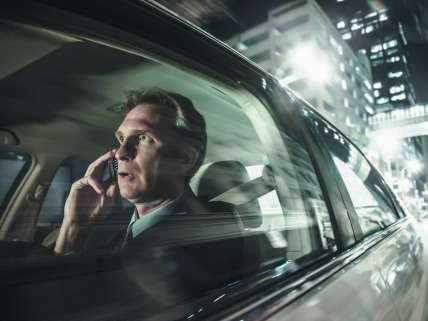Why New Cellphone Restrictions Won't Have a Noticeable Impact on Crashes
Cellphones figure in something like 1 percent of traffic fatalities, and holding them is not the main distraction.

In 2015, according to numbers released this week by the National Highway Traffic Safety Administration (NHTSA), "distraction-affected crashes" killed 3,477 people in the United States. A California law that took effect on Sunday, imposing further restrictions of drivers' use of cellphones, is supposed to do something about that problem, but there is little reason to think it will.
NHTSA's numbers indicate that cellphones are implicated in just 13 percent of traffic fatalities involving distracted drivers—which in turn account for 10 percent of traffic fatalities, meaning that cellphones play a role in something like 1.3 percent of deaths caused by car crashes. The vast majority of distraction-related crashes involve less commonly discussed (and less vociferously condemned) activities such as "eating and drinking," "talking to passengers," "grooming," "reading, including maps," and "adjusting a radio, CD player, or MP3 player." If it does not make sense for states to pass laws specifically prohibiting each of these distractions, why single out cellphones?
Another problem with California's approach is that it seeks to stop drivers from holding cellphones while still allowing hands-free use. But according to NHTSA, "the research indicates that the cognitive distraction of having a hands-free phone conversation causes drivers to miss the important visual and audio cues that would ordinarily help you avoid a crash." Or as Steve Finnegan, government affairs manager at the Automobile Club of Southern California, tells The New York Times, "It's not what your hands are doing; it's what your brain is doing." All 14 states that restrict drivers' cellphone use nevertheless say hands-free calls are OK, and no state prohibits conversations with passengers, which are at least as distracting.
Cellphone restrictions have not had a measurable impact on traffic fatalities. David Kidd, a senior researcher at the Insurance Institute for Highway Safety, tells the Times "there is evidence that if you do pass a law and have strong enforcement, it can change behavior." But he adds that "we don't see a reduction in crashes that is consistent with that change in behavior." That's not surprising, since these laws deal with a highly visible, relatively novel factor that figures in 1 percent of car accidents, imposing restrictions that even theoretically can make a difference in only a fraction of that 1 percent—the accidents where holding a phone plays a crucial role.
The Times notes that Kidd's organization "is more focused on encouraging automakers to adapt crash avoidance technologies such as forward collision warning and automatic emergency breaking, both technological measures that are intended to help prevent front-to-rear crashes." As Kidd explains, these safety features "are not going to reduce driver distraction, but they will help cope with some of the consequences that come with drivers not paying attention."
The difference in focus between legislators and insurers can be explained by a difference in motives. While insurers have a financial incentive to reduce their payouts by reducing crashes, legislators have a political incentive to seem like they are addressing the problem, whether or not the policies they support actually have an impact.


Show Comments (75)